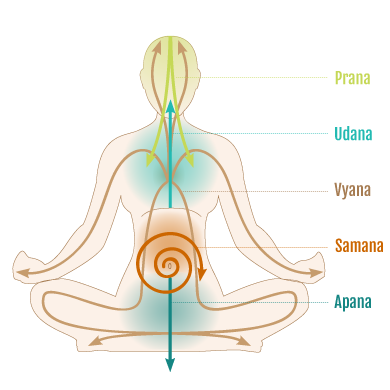Pancha Vayus
Our theme for March was the Pancha Vayus.
These are the 5 winds or pranas, different to Prana, life force.
Va = ‘motion’ or ‘that which flows’ (Prana and Pranayama). The vayus represent the flow of subtle energy within the 5 Koshas, the layers that make up our being.
prana vayu
Also known as sthoola (gross) prana. This is the upward or forward moving air. It moves inward and upward governing the reception of food, drink and experiences into the body and mind. prana vayu provides our basic energy, is propulsive in nature and sets things in motion.
In practise we focussed on the inhale, the upward experience, which can be likened to a bubbling spring originating at Anahata Chakra (heart centre) to Vishuddhi Chakra (throat). As well as focussing on the inhalation, we included poses such as Dwi Pada Peetham (bridge pose), Tadasana (mountain pose), Vrksasana (tree pose).
Apana vayu
The opposite to prana vayu as this is the downward moving energy, elimination, things that the body ejects. It relates to the exhalation, elimination, reproduction and birth. It is no surprise therefore that it is related to Swadisthana Chakra (sacral) and Muladhara Chakra (root). During our practice we envisaged a letting go of the emotional qualities and samskaras (subtle impressions of our past actions, habits) that no longer serve us, focussing on the exhale and grounding practices that allow us to let go. Practices included lengthening the exhale, squats, Eka Pada Rajakapotasana (pigeon), Tadasana (mountain).
Samana Vayu
Samana digests that which is taken in by prana vayu and sends nourishment to the body and Koshas. That which is not needed is expelled through apana. It is therefore associated with the Manipura Chakra (solar plexus). Samana doesn’t deal with air, water and food alone but includes our experiences, sensory, emotional and mental. We can aid its action through abdominal breathing and any asana practices that stimulate Manipura such as Marjariasana (cat), Navasana (boat, twists and Surya Namaskar (sun salutes).
Udana Vayu
This is an upward moving air governing our physical growth, connection with gravity, movement of legs, arms and head. In addition it is responsible for the sensory organs - ears, eyes, nose, tongue, skin. Udana assists in the actions of prana and apana, intake and expellation. Governing the functions of the throat and mouth, we associate it with Vishuddhi Chakra (throat), however it also pervades Ajna (eyebrow centre), Bindhu (centre of the head) and Sahasrara Chakras (crown). We experienced it in classes through blue spirals of energy around the limbs, spine and head, and included twists to enhance the spiral motion.
Vyana Vayu
Vyana moves from the centre outwards via the Nadis, the energy channels similar to the meridians in TCM. It governs the circulation of all fluids - circulatory system, lymphatic system, passage of oxygen and fluids throughout the tissues and the circulation of consciousness. Fluids and consciousness pass through all the Koshas and pervade the energy field. We imagined our energy field as a glow around the body, such as in a well known hot oat cereal advert. During our practice we imagined the energy pervading and radiating out through our Koshas and noted that working with the breath balanced this vayu. We introduced movements that promoted the circulation of the lymph such as Tibetan massage, twists, head movements and the Albatross sequence, practising with grace and fluidity. We also brought in Jalandhara Bandha which not only works with the upper lymphatics in the neck but is also fluid in nature (jala = river). Due to its fluid nature we associate this vayu with Swadisthana Chakra.
The vayus work together throughout the Koshas. When one of the them is out of balance they are all affected. Through the practise of Yoga, and especially working with the breath, we promote health and balance.
Inspired by Prana and Pranayama, Swami Niranjanananda Saraswati, (2012) Yoga Publications Trust, Bihar, India.

